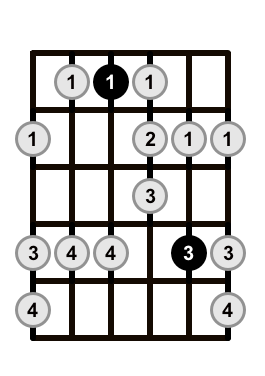
In this lesson, we’re going to look at the Major Blues scale. In the previous lesson, we explored the Minor Blues scale and discussed why it is arguably the most popular scale for guitarists.
The Major Blues scale is also a very useful scale, but it is not used as often as the Minor Blues scale. The Minor Blues scale seems to work over most chords including major chords and minor chords. The Major Blues however, only really works over Major chords, because it contains a ‘natural 3’, which clashes with the ‘b3’ of minor chords.
So What Is The Major Blues Scale?
Just like any scale, we can look at the Major Blues in terms of intervals:
- (from root note) – T – S – S – min 3 – T – min 3 (root note again)
We can also look at the scale in terms of the notes that it contains, relative to the major scale:
- Root – 2 – b3 – 3 – 5 – 6
Just like we did with the Minor Blues scale, let’s look at one shape of the Major Blues and then play it in an example key using notes/tabs.

Example of G Major Blues

We’re going to look at five positions of the Major Blues shortly, but first let’s explore the Major Blues a little further. Also, this lesson assumes that you already know certain things about reading and applying scales. If you’re unsure of something, the links at the bottom of this page under the heading ‘Further Reading’ should help you out.
Major Blues And Major Pentatonic
When we explored the Minor Blues scale, we saw that it was really just a Minor Pentatonic scale, with one extra note added in. The Major Blues is actually just a Major Pentatonic Scale with a note added.
Observe the following comparison between the Major Pentatonic scale and the Major Blues scale.
Major Pentatonic Scale

Major Blues Scale

As you can see, there is only one note (the ‘b3’) that is added to the Major Pentatonic scale to produce the Major Blues scale. The extra note occurs twice in the above diagram, but it is the same note, in two octaves.
Why The Minor 3rd?
You might be asking, how can the Major Blues scale contain a ‘b3’? After all, the b3 is the note that turns a major chord or scale into a minor chord or scale! This is a little bit confusing, but the thing to realise is that it also contains a ‘natural 3’ as well. Let’s revisit the notes in the Major Blues scale.
R – 2 – b3 – 3 – 5 – 6
As you can see, it contains both the ‘b3’ and the ‘3’. When used together in a scale, the ‘natural 3’ gives the scale its ‘major sound’, and the ‘b3’ adds a blues flavour to the scale. This is a bit of a generalisation, but it will suffice for now. The ‘b3’ can be interpreted as a ‘#9’, which is another reason why the two notes can exist together, but that’s getting into a bit of theory which is beyond the scope of this lesson.
For now think of it like this:
- Natural 3 = ‘Major’ quality.
- Flat 3 = ‘Blues’ quality.
This is why the Minor Blues scale can also be used over major chords – the ‘b3’ of the scale just adds a bluesy quality.
Ironically, the Major Blues cannot be used (generally) over minor chords, because of the ‘natural 3’!
Confused? It’s ok, if all of this doesn’t quite make sense, it doesn’t matter. The beauty of scales is that you can learn them and use them even without fully understanding the accompanying theory. Your knowledge of theory, which is important, can be developed as you are becoming familiar with the scale.
Major Blues Vs Minor Blues
Before we look at the five positions of the Major Blues scale, it’s worth noting that the Major Blues and Minor Blues both contain the same set of intervals, but from a different starting point.
- T – S – S – m3 – T – m3
- m3 – T – S – S – m3 – T
As you should be able to see, both scales use the same set of intervals, but starting from a different place. This effectively makes the two scales relative to each other.
The following two images should demonstrate this further.
Major Blues Scale

Minor Blues Scale

What this means, is that by learning the five Minor Blues shapes, you are actually learning the five Major Blues shapes at the same time, but starting from a different note in the shape. This is best understood by playing through the shapes of both scales and comparing them.
Using The Major Blues Scale
As I mentioned before, the Major Blues scale works well over major chords. It creates a ‘bluesy’ sound that has a certain quirkiness to it, which is different than the Minor Blues scale. It almost has a country flavour. We’re not going to dive too far into the practical applications of the scale in this lesson. The purpose of this lesson is to look at what the scale is and 5 positions of it. I will post lessons on using the Major Blues scale in the future. For now, learn the scale in all five positions and experiment with it.
5 CAGED Positions Of The Minor Blues Scale
Let’s look the Minor Blues scale in five different CAGED positions along the fretboard. If you’re not sure why five positions is important, read this lesson.





Individual Keys
I will post links to individual keys of the Major Blues scale soon.
Further Reading
- Scales Page – The scales page of this website.
- How To Read Scale Diagrams – A lesson on how to read scale diagrams (like the ones in this lesson).
- The CAGED system – What is the CAGED system and the importance of learning scales in 5 positions.
- Position Playing – How to practise scales by staying in one position.
- Minor Blues Scale – A lesson on the Minor Blues Scale
